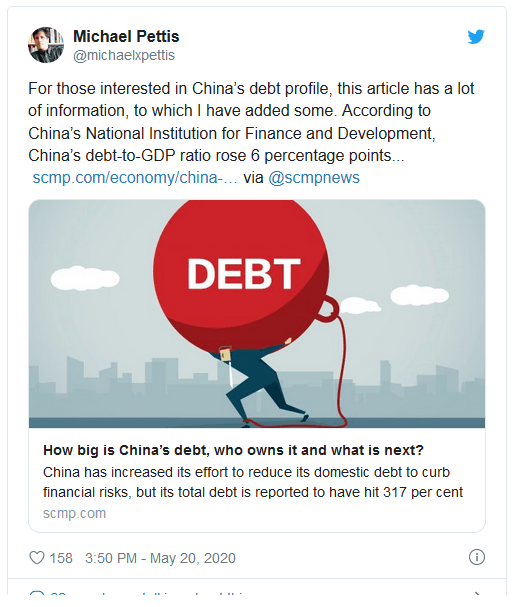The IIF estimates that China’s total debt hit 317 per cent of gross domestic product (GDP) in the first quarter of 2020.
Michael Pettis at China China Financial Markets comments on China's debt in a Tweet Thread.

Thread
- For those interested in China’s debt profile, this article has a lot of information, to which I have added some. According to China’s National Institution for Finance and Development, China’s debt-to-GDP ratio rose 6 percentage points.over 2019 to 245% by the end of the year.
- According to the Institute of International Finance – which includes categories of debt not counted by NIF – China’s debt-to-GDP ratio rose 11 percentage points in 2019 to 310%, and rose a further 7 percentage points this year.during Q1 to 317%.
- As high as these increases are, my own estimates are that either debt-to-GDP measure will rise by at least 12-18 percentage points in 2020. I would add four additional points.
- First, almost everyone agrees that some categories of debt are not fully accounted for in the data, so both numbers are likely to be understated.
- Second, because China’s GDP measure is not comparable to the GDP of other countries, but overstates it on a relative basis (see the essay below), its debt-to-GDP ratio should .be adjusted upwards to make it comparable.
- Third, debt data for any country always excludes financial debt because to the extent that a financial system is solvent, it’s financial assets and financial liabilities can be netted out.
- But because the liabilities of Chinese banks probably exceed the real economic value of their assets, the difference represents a contingent claim on the government that is not included in any of the debt data.
- Finally, unlike most governments, Beijing and local governments have substantial asset positions (real estate and SOEs). These can in principle be used to absorb some of the debt-servicing costs, although to date this has proven politically very difficult.
- China’s foreign debt has risen sharply from $0.55 trillion dollars ten years ago to $2.05 trillion today, according to this article, but at less than 15% of GDP, and equal to 2/3s of visible reserves, I think it is still quite manageable.
Note: I reformatted the thread to keep key ideas in the same numbered point. In doing so, I increased the number of points by one.
This material is based upon information that Sitka Pacific Capital Management considers reliable and endeavors to keep current, Sitka Pacific Capital Management does not assure that this material is accurate, current or complete, and it should not be relied upon as such.
Recommended Content
Editors’ Picks
EUR/USD clings to daily gains above 1.0650

EUR/USD gained traction and turned positive on the day above 1.0650. The improvement seen in risk mood following the earlier flight to safety weighs on the US Dollar ahead of the weekend and helps the pair push higher.
GBP/USD recovers toward 1.2450 after UK Retail Sales data

GBP/USD reversed its direction and advanced to the 1.2450 area after touching a fresh multi-month low below 1.2400 in the Asian session. The positive shift seen in risk mood on easing fears over a deepening Iran-Israel conflict supports the pair.
Gold holds steady at around $2,380 following earlier spike

Gold stabilized near $2,380 after spiking above $2,400 with the immediate reaction to reports of Israel striking Iran. Meanwhile, the pullback seen in the US Treasury bond yields helps XAU/USD hold its ground.
Bitcoin Weekly Forecast: BTC post-halving rally could be partially priced in Premium

Bitcoin price shows no signs of directional bias while it holds above $60,000. The fourth BTC halving is partially priced in, according to Deutsche Bank’s research.
Week ahead – US GDP and BoJ decision on top of next week’s agenda

US GDP, core PCE and PMIs the next tests for the Dollar. Investors await BoJ for guidance about next rate hike. EU and UK PMIs, as well as Australian CPIs also on tap.
